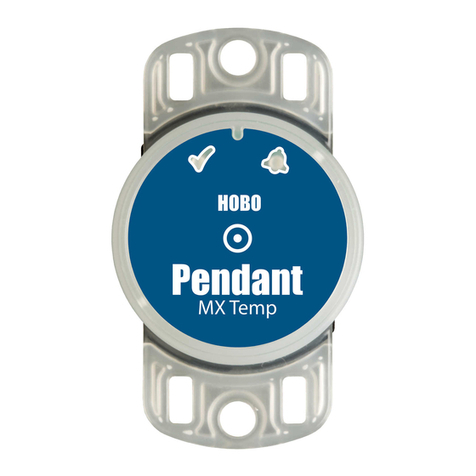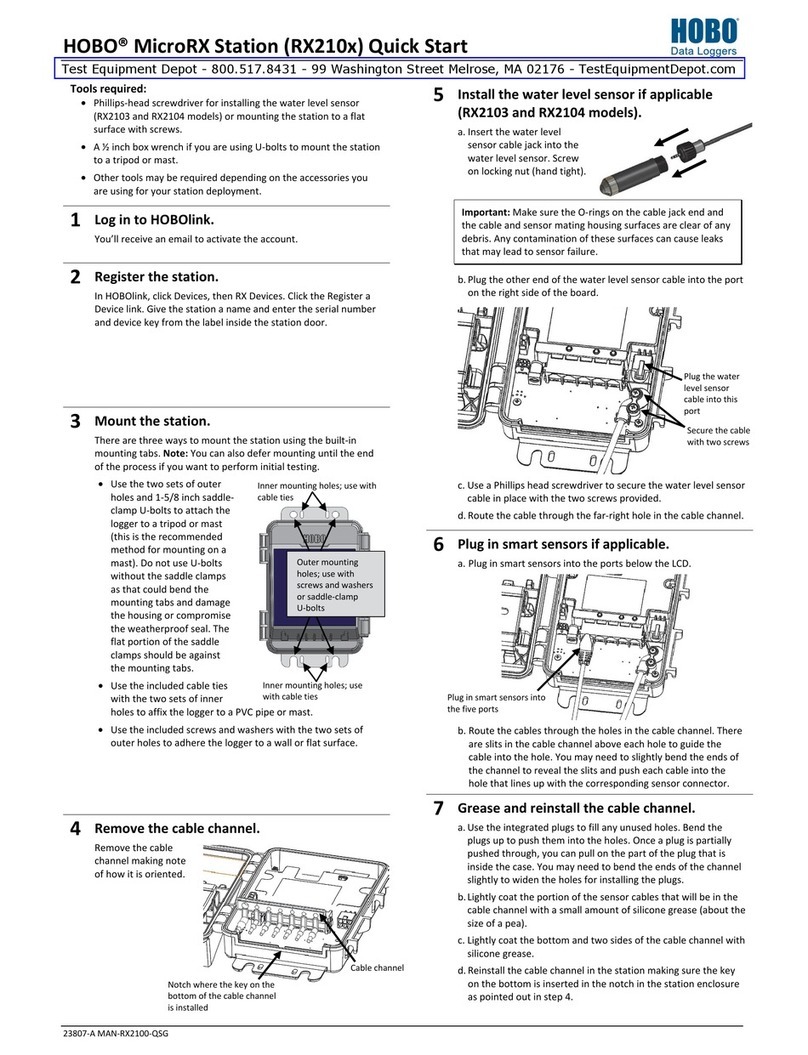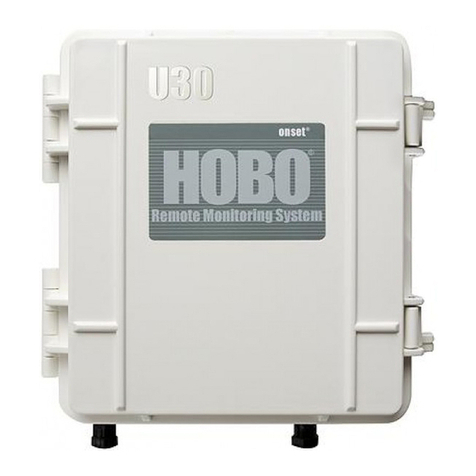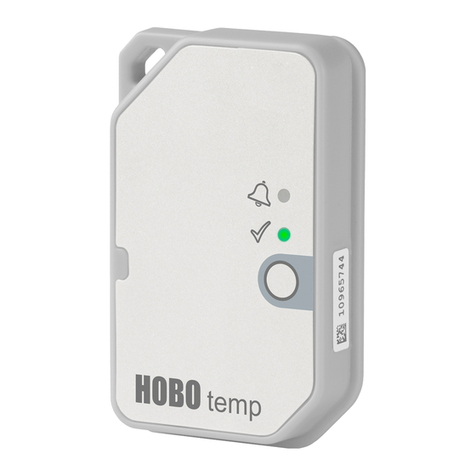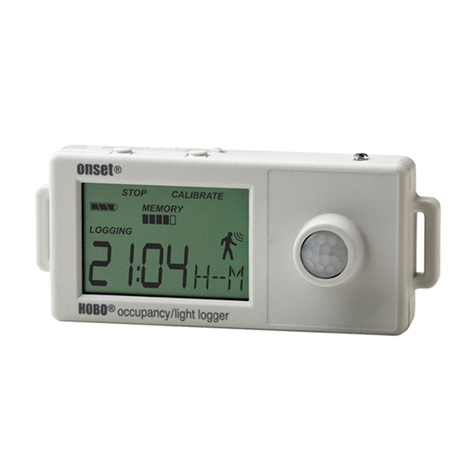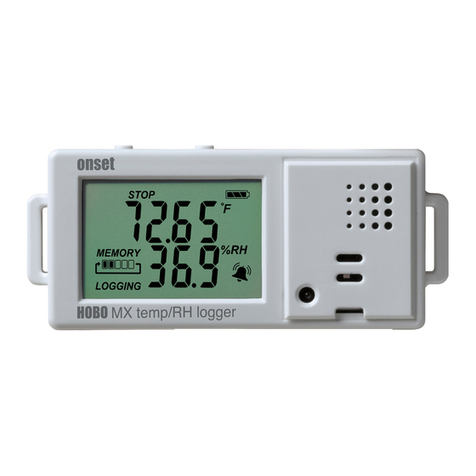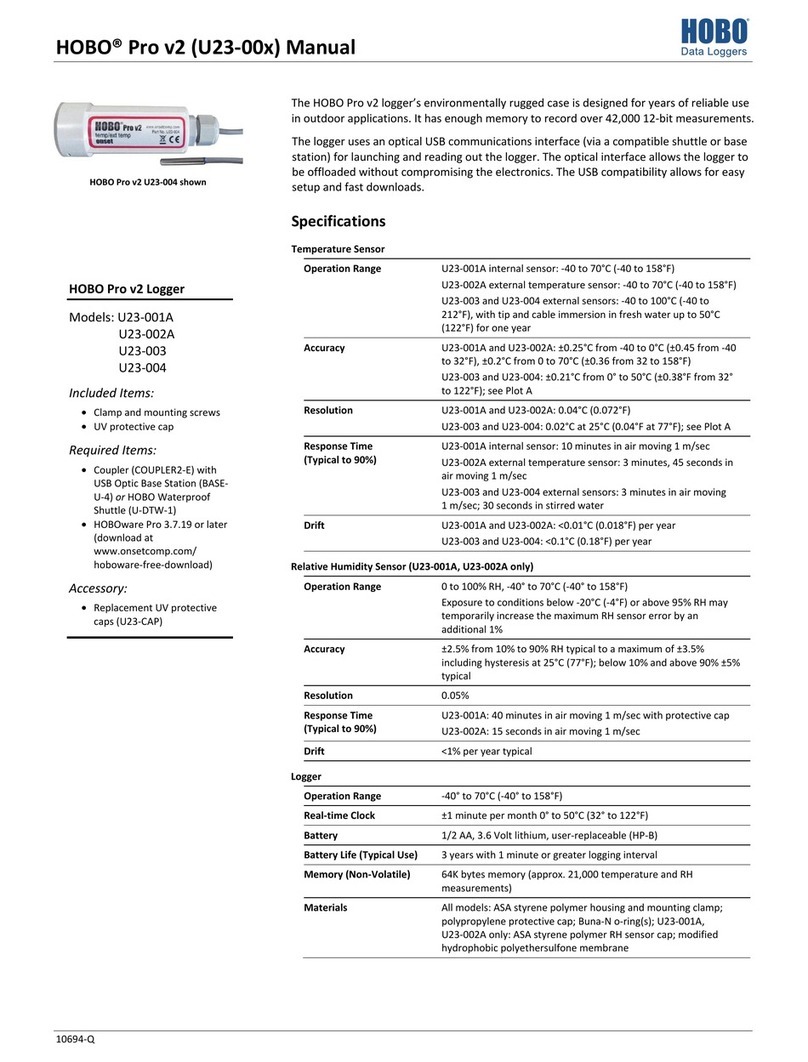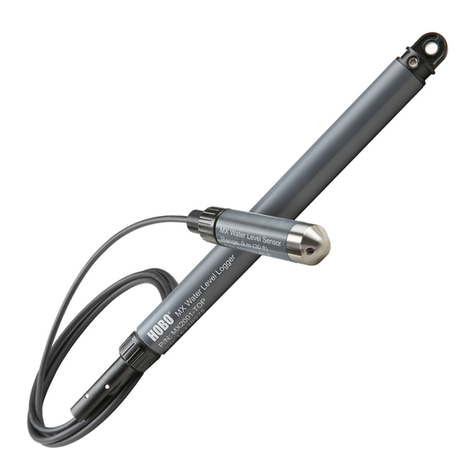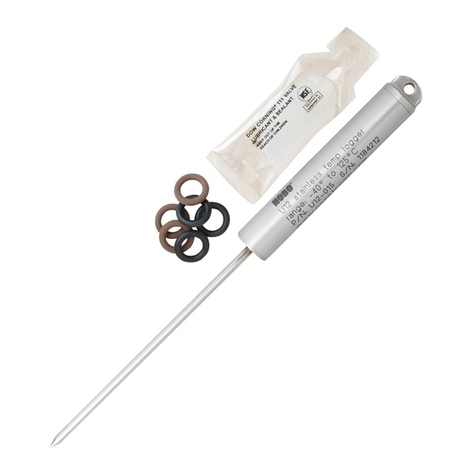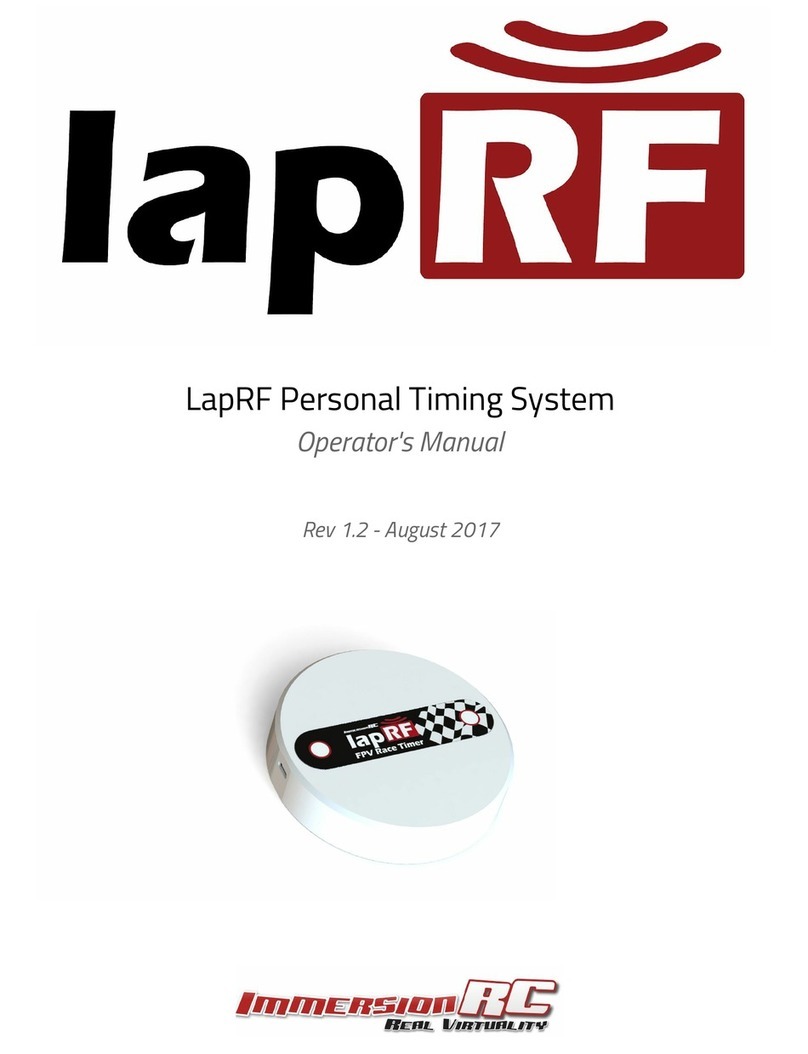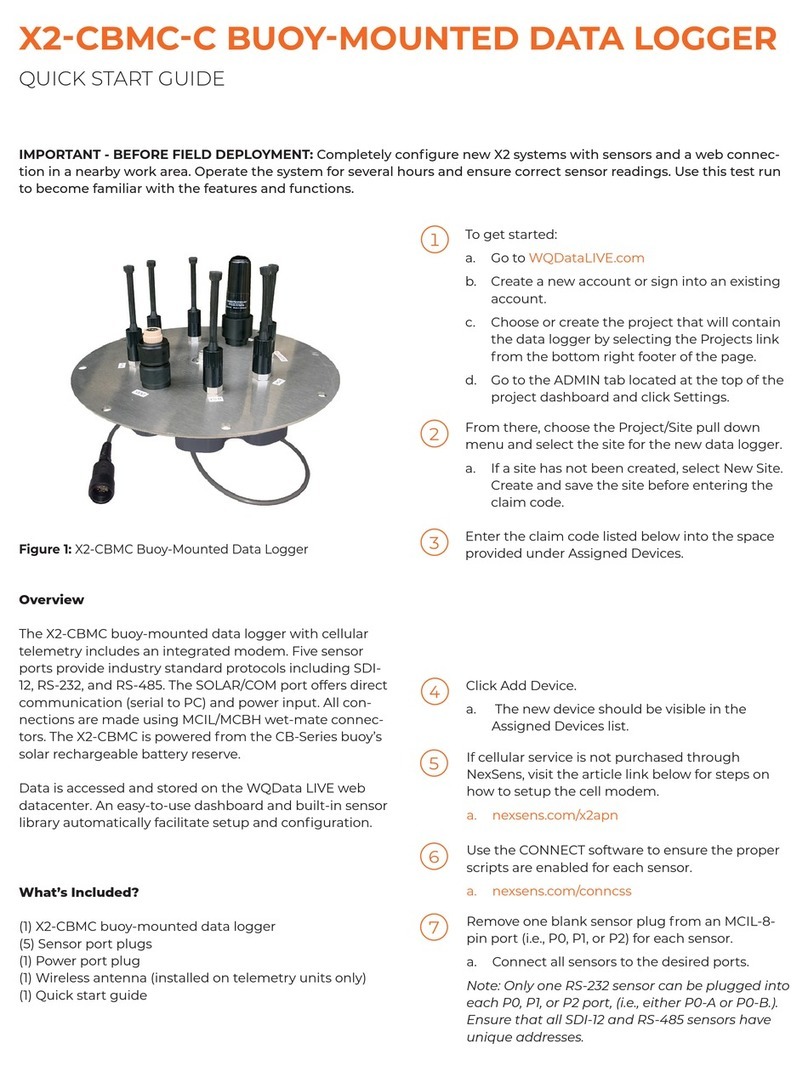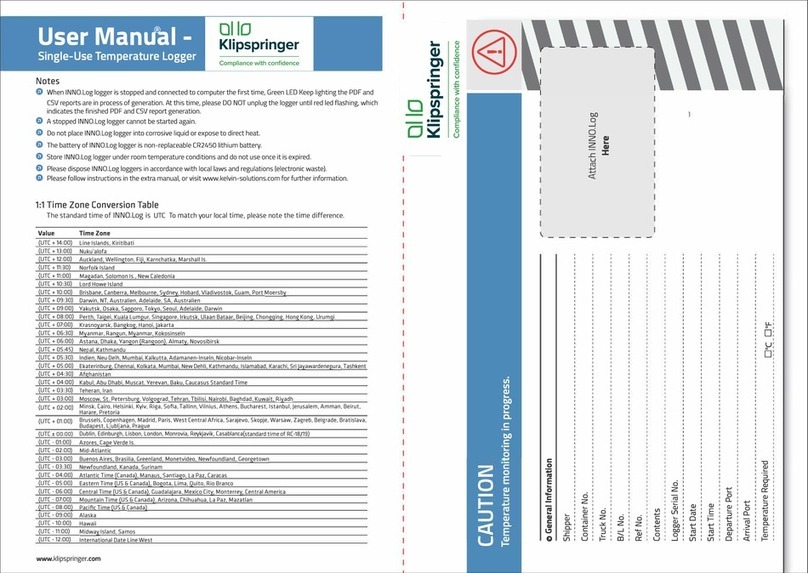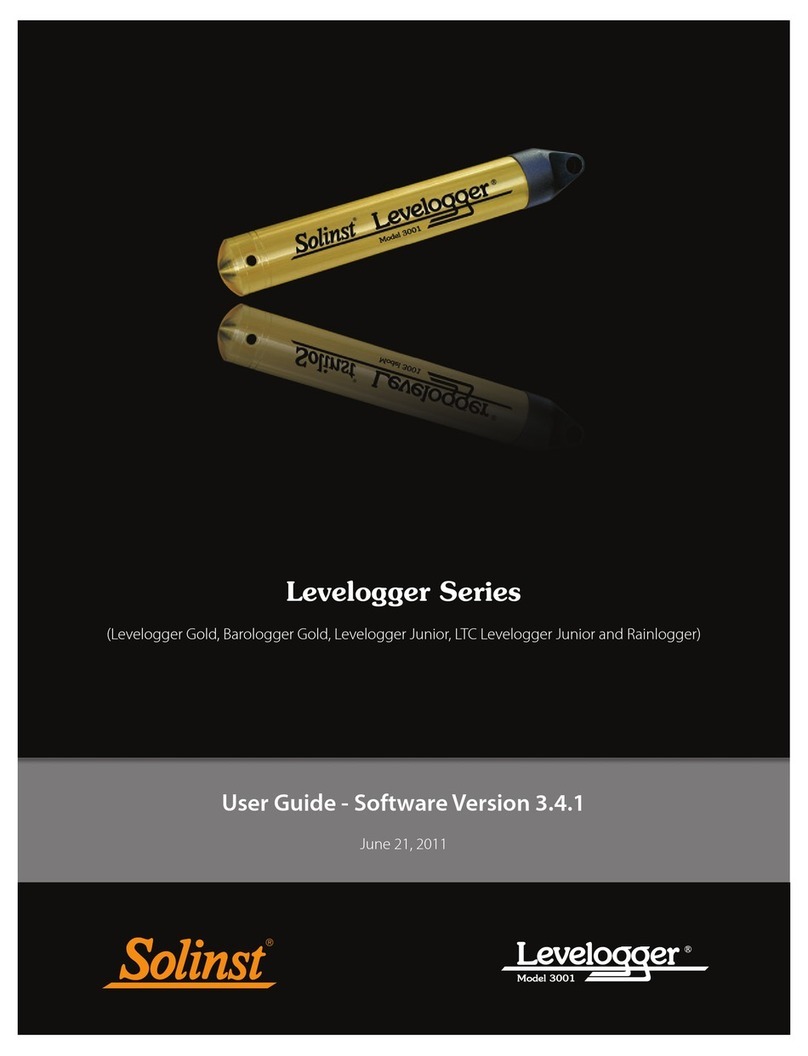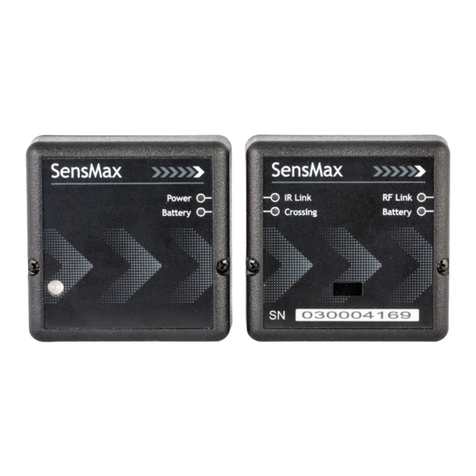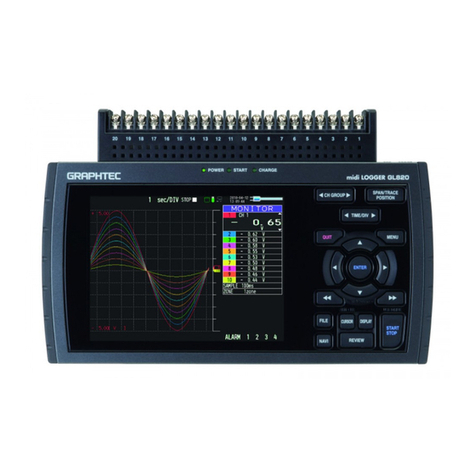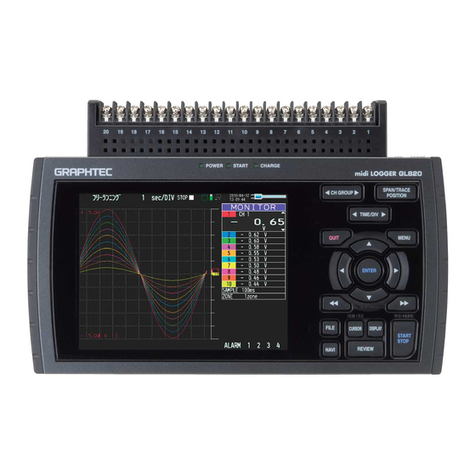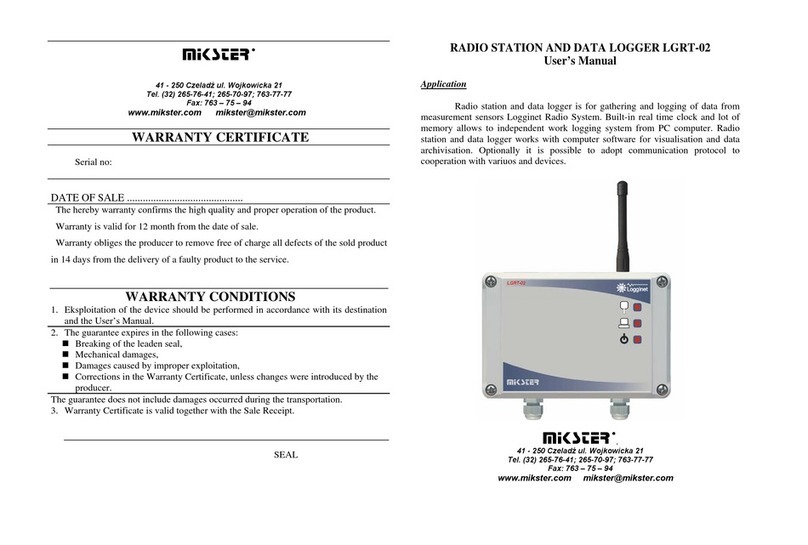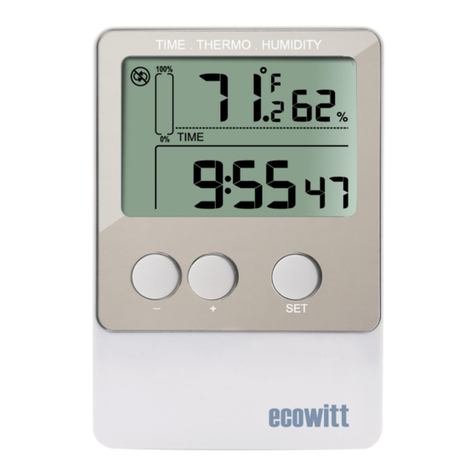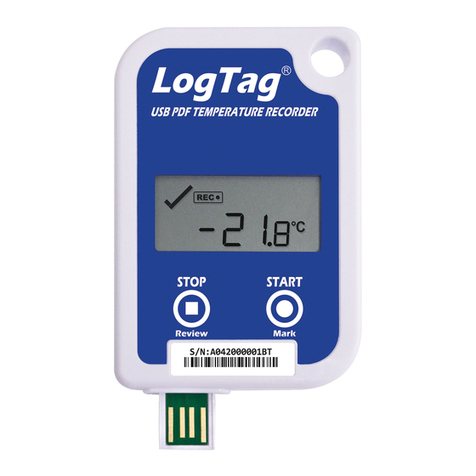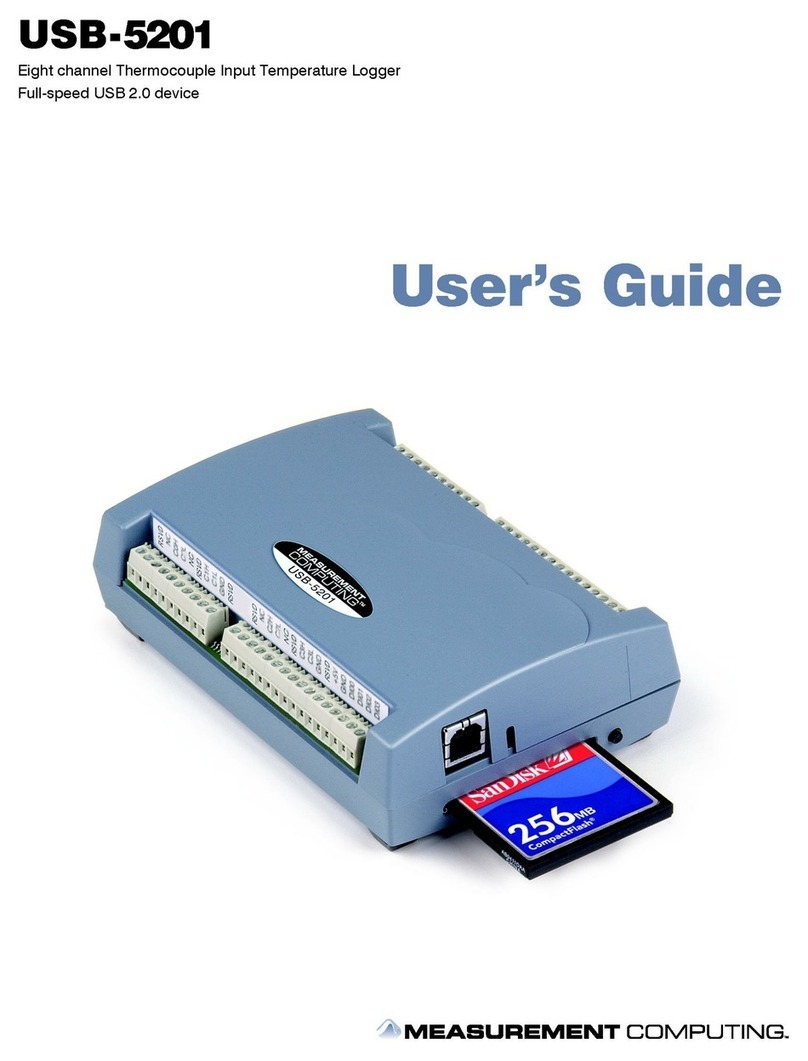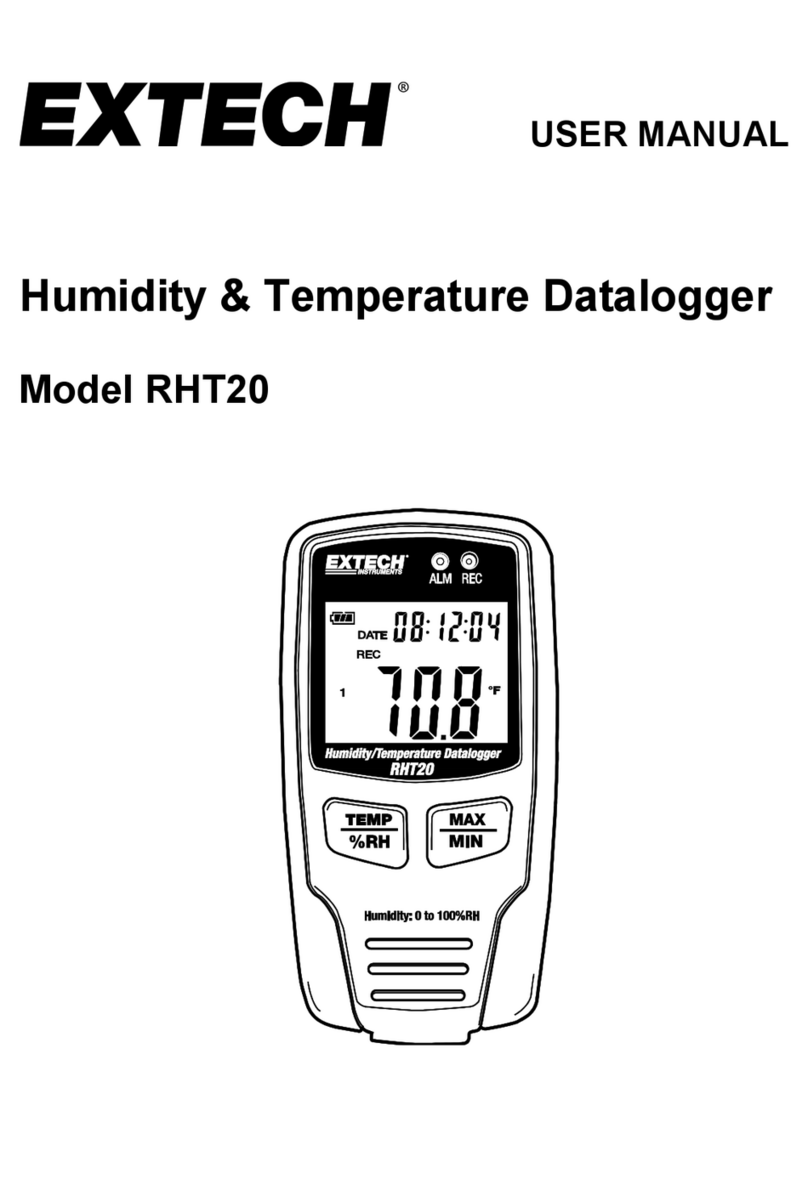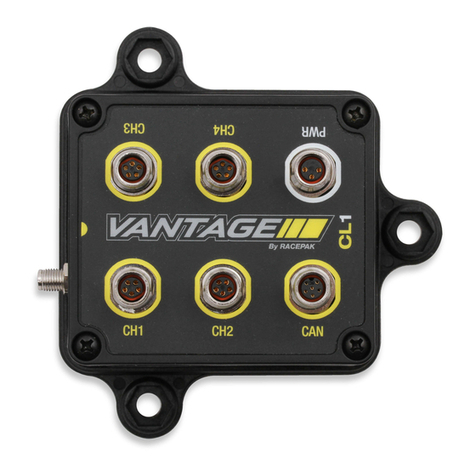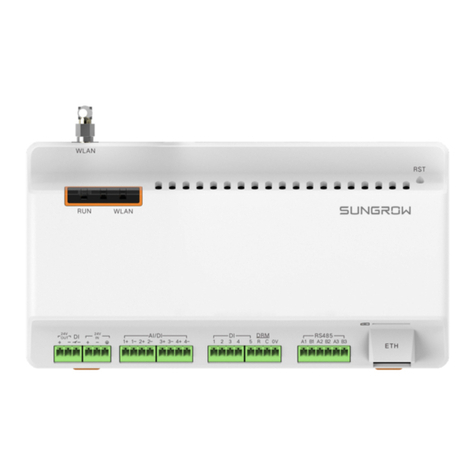Hobo HOBOnet RX2105 User manual

HOBO® MicroRX Station for HOBOnet® (RX2105 and RX2106) Manual
24500-C
The HOBO MicroRX Station for HOBOnet provides continuous logging for both indoor and
outdoor environments with wireless sensor motes and up to five smart sensors. Logged data
from the station is transferred at regular connection intervals to HOBOlink® web-based
software where you can check the latest conditions, view graphs, configure sensors and alarms,
set up a dashboard, download your data, or schedule data delivery via email or FTP. This
durable, compact station has a built-in LCD screen to check the current system configuration
and status, start and stop logging, add and remove sensors, and connect to HOBOlink on
demand. The station offers two primary power source options depending on your deployment
needs: the RX2105 model includes user-replaceable AA lithium batteries and an AC adapter
while the RX2106 model is designed with a built-in solar panel and rechargeable NiMH battery
pack.
Specifications
Station
Operating
Range RX2105: -40° to 60°C (-40° to 140°F)
RX2106: -20° to 60°C (-4° to 140°F)
Smart
Sensor Connectors 5
Smart Sensor Network Cable
Length
100 m (328 ft) maximum
Smart Sensor Data
Channels Maximum of 15 (some smart sensors use more than one data
channel; see sensor manual for details)
Logging Rate
1 minute to 18 hours
Time Accuracy
±8 seconds per month in 0° to 40°C (32°F to 104°F) range;
±30 seconds per month in -40° to 60°C (-40° to 140°F) range
Battery Type
/Power Source RX2105: AC power adapter (P-AC-1) and 6 AA 1.5 V lithium batteries
RX2106: Integrated 1.7 watt solar panel and NiMH rechargeable
battery pack; optional AC power adapter (P-AC-1) or external solar
panel (SOLAR-xW) can be used in place of integrated solar panel
Battery Life
/Power Source RX2105:
Runs continuously with the included AC adapter.
Batteries can be used as a backup to AC power; battery life of 3
months with 1 minute logging and daily connections or 2 months
with 1 minute logging and hourly connections, and with
approximately 10 motes. Note: Deployments in areas with weak
cellular strength could reduce battery life.
RX2106:
Typical 3–5 years when operated in the temperature range -20° to
40°C (-4° to 104°F); operation outside this range will reduce the
battery service life.
Maximum connection rates with built-in solar panel, in full sun:
•10 minute connections year round for latitudes less than ±40°
•10 minute connections through three seasons in other regions,
reduced to 30 minute connections in winter
Maximum connection rates with external 5W or 15W solar panels:
•10 minute connections year round, in full sun
•Connection rate with external solar panels may be less if
deployed in partial sun
Battery life of 1 month without solar recharging, with hourly
connections, 1 minute logging, and approximately 10 motes.
Alarm Notification Latency
Logging interval plus 2–4 minutes, typical
Enclosure Access
Hinged door secured by two latches with eyelets for use with user-
supplied padlocks
LCD
LCD is visible from 0° to 50°C (32° to 122°F); the LCD may react
slowly or go blank in temperatures outside this range
Materials
Outer enclosure: Polycarbonate/PBT blend with brass inserts;
Interior: Polycarbonate/PBT; Gasket: Silicone foam; Cable channel:
Santoprene™ TPE; U-Bolts (not included): Steel with zinc dichromate
finish
HOBO MicroRX Station for
HOBOnet
Models:
RX2105 MicroRX Station
RX2106 MicroRX Station with
Solar Panel
•RX210x-900 (US)
•RX210x-868 (Europe)
•RX210x-921 (Taiwan)
•RX210x-922 (Australia/NZ)
Included Items:
•RX Manager
•Grease packet
•Screws and washers
•Cable ties
•Six AA lithium batteries and
AC adapter (P-AC-1) with
RX2105
•Rechargeable battery pack
with RX2106
Required Items:
•HOBOlink
•HOBOnet RXW motes
Optional Items:
•Smart sensors
•Ground wire (CABLE-
MICRO-G)
•2-meter tripod (M-TPB)
•3-meter tripod (M-TPA)
•1.5 meter mast (M-MPB)
•1-5/8 inch U-bolts (U-BOLT-
KIT2)
•Guy wire kit (M-GWA)
•1/2 inch stake kit (M-SKA)
Sensors and accessories are
available at
www.onsetcomp.com.
RX2105 model shown

HOBO MicroRX Station for HOBOnet (RX2105 and RX2106) Manual
1-800-LOGGERS 2 www.onsetcomp.com
Specifications (continued)
Dimensions
19.95 x 13.68 x 7.49 cm (7.85 x 5.39 x 2.95 in.); see diagrams at left
Weight
678 g (23.9 oz)
Mounting
Optional U-bolts are compatible with masts up to 4.14 cm (1.63 in.)
mast diameter; can also be mounted with zip ties or mounted to a flat
surface with screws
Environmental Rating
Weatherproof enclosure, NEMA 4X and IP66 (requires proper
installation of cable channel system)
Wireless Radio
GSM/GPRS/EDGE: Quad band 850/900/1800/1900 MHz
UMTS/HSPA+: Seven band 800/850/900/1800/1900/2100 MHz
LTE: Twelve Band 700/800/850/900/1800/1900/2100/2600 MHz
Antenna
4G LTE
The CE Marking identifies this product as complying with all relevant
directives in the European Union (EU)
See last page, FCC ID QIPPLS62-W, IC ID:7830A-PLS62W
Manager
Operating Range
-25° to 60°C (-13° to 140°F)
Radio Power
12.6 mW (+11 dBm) non-adjustable
Transmission Range
Reliable connection to 457.2 m (1,500 ft) line of sight at 1.8 m (6 ft)
high
Reliable connection to 609.6 m (2,000 ft) line of sight at 3 m (10 ft) high
Wireless Data Standard
IEEE 802.15.4
Radio Operating Frequencies
RX210x-900: 904–924 MHz
RX210x-868: 866.5 MHz
RX210x-921: 921 MHz
RX210x-922: 916–924 MHz
Modulation Employed
OQPSK (Offset Quadrature Phase Shift Keying)
Data Rate
Up to 250 kbps, non-adjustable
Duty Cycle
<1%
Maximum Number of Motes
Up to 50 wireless sensors or 336 data channels per one HOBO RX
station
Power Source
Powered by the station
Dimensions
Mote: 16.2 x 8.59 x 4.14 cm (6.38 x 3.38 x 1.63 inches)
Cable length: 2 m (6.56 ft)
Weight
159 g (5.62 oz)
Materials
PCPBT, silicone rubber seal
Environmental Rating
IP67, NEMA 6
Dimensions
13.68 cm
(5.39 in.)
19.95 cm
(7.85 in.)
7.49 cm
(2.95 in.)
5.3 cm
(2.1 in.)
3.2 cm
(1.25 in.)

HOBO MicroRX Station for HOBOnet (RX2105 and RX2106) Manual
1-800-LOGGERS 3 www.onsetcomp.com
Device Components and Operation
RX2105 model shown
Internal RX2106 model shown
RX2106 model shown
Station Door: This is the protective, hinged door covering the
LCD and electronics. The station serial number and device key
needed for HOBOlink registration are located on the inside of
the door.
Battery Holder: The location where batteries are installed (AA
1.5 V lithium batteries for RX2105 models or a NiMH battery
pack for RX2106 models); see both Battery Information
sections.
Manager: The mote connected to the station that transmits
and receives data to and from wireless motes in the network.
Micro SIM Card: This enables cellular communications.
USB Port: Use this port to connect the station to the computer
via USB cable as needed for HOBOware® if you are installing
your own micro SIM card or for data offload to CSV file.
LCD Screen: This shows details about system, module, and
sensor operation (see LCD Operation).
Solar Panel Port: In RX2106 models, use this port to plug in the
built-in solar panel or an external solar panel with a higher
wattage (see Setting up the Station).
Battery Port: Use this port to plug in the internal battery cable
(see Setting up the Station and both Battery Information
sections).
AC Adapter Port: Use this port to plug in an AC adapter (see
both Battery Information sections).
Smart Sensor Connectors: Use these input jacks to connect up
to 5 smart sensors (see Setting up the Station). The station can
support up to 15 smart sensor data channels; some smart
sensors have more than one data channel.
Cable Channel Plugs: Use these plugs to fill empty holes in the
cable channel (see Installing the Cable Channel).
Cable Channel: Use this for routing sensor cables and other
wires to protect the interior of the station or to create a
weatherproof seal. Any open holes should be sealed with the
integrated plugs (see Installing the Cable Channel).
Manager Port: This port is used to connect the manager for
wireless network communications.
Connect/Search Button: Use this button to connect to
HOBOlink or search for new smart or wireless sensors (see LCD
Operation).
Start/Stop Button: Use this button to start and stop logging or
clear a fault code (see LCD Operation).
Select Button: Use this button to cycle through information
about the smart sensors and manager module (see LCD
Operation).
Mounting Holes: Use the inner or outer holes at the top and
bottom of the logger to mount it (see Mounting the Station).
Solar Panel: This is the 1.7 watt solar panel built into the front
of the station door in RX2106 models.
Grounding Wire Port: Use this port on the back of the station
to connect a grounding wire (CABLE-MICRO-G) (see Installing
the Grounding Wire).
Vent: This vent allows pressure to equalize inside the station
while keeping water out.
Micro SIM
Card
Battery Port
LCD Screen
USB Port
Connect/
Search
Button
Start/
Stop
Button
Select
Button
Manager Port
Solar Panel
Port
AC Adapter
Port
Smart Sensor
Connectors
Cable Channel
Grounding
Wire Port
Vent
Solar panel
Mounting Holes
Battery Holder
Station Door
Manager
Cable Channel
Plugs

HOBO MicroRX Station for HOBOnet (RX2105 and RX2106) Manual
1-800-LOGGERS 4 www.onsetcomp.com
Manager
Mounting Tab: Use the tabs at the top and bottom of the mote
to mount it (see Deployment Guidelines).
Cable: Use this cable to connect the manager to the station.
Eyelet: Use this eyelet to attach a 3/16 inch padlock to the
mote for security.
Latch: Use the two latches to open and close the mote door.
Antenna: This is the built-in antenna for the radio
communications across the wireless network.
USB Port: Use this port to connect to the mote to a computer
via USB cable if you need to update the firmware (see Updating
Manager Firmware).
LCD Operation
This example shows all symbols illuminated on the LCD screen with an overview of what each section of the LCD represents. Refer to the
table below for details about each section and associated symbols.
System Status
This part of the LCD shows the overall system status.
or
When the station is powered up, “Initializing System” flashes in the upper left part of the LCD. After initialization is
complete, “System” remains illuminated and one of these symbols will appear:
indicates the system is ok.
indicates there is a problem with the system; check the Device Information panel on your station page in
HOBOlink.
Connection Status
This part of the LCD shows the status of the HOBOlink connection and other items.
This indicates the station is connected to a USB cable.
This shows the strength of the cellular signal; the more bars there are, the stronger the signal. This will blink while
connecting to HOBOlink.
or
When the station is attempting to connect or is currently connected to HOBOlink, “Connection” flashes on the LCD.
After the connection is complete, “Last Connection” remains illuminated and one of these symbols will appear:
indicates the last connection to HOBOlink was ok.
indicates there was a problem with the last connection; check the Connections log in HOBOlink.
Smart Sensor and
Module Status
This part of the LCD shows the status of the smart sensors and the manager. One of the following symbols will also
appear next to smart sensors or module 2 for the manager:
indicates the smart sensor or manager module is ok.
indicates there is a problem with the smart sensor or manager module; check your device page in HOBOlink.
indicates a sensor alarm has tripped and will flash on the LCD until the alarm is cleared; check the Alarms log
in HOBOlink.
Logging Status This part of the LCD indicates whether the station is currently logging.
or
“Stopped” indicates the station is not currently logging while “Logging” indicates it is currently logging. Press the
Start/Stop button to start or stop logging as desired. Note that “Logging” will blink until the first data point is logged
after the Start button is pressed. Pressing Start will also initiate a connection to HOBOlink. Pressing Stop will stop
logging, but it will not initiate a connection to HOBOlink.
System Status
Connection Status
Manager Status
Logging Status
Battery and Memory Status
Channel and Device
Information
Button Symbols
Latch
Eyelet
Cable
Antenna
USB Port
Mounting
Tab

HOBO MicroRX Station for HOBOnet (RX2105 and RX2106) Manual
1-800-LOGGERS 5 www.onsetcomp.com
Battery and
Memory Status
This part of the LCD shows the current battery level and memory.
or
The battery indicator shows the approximate battery power remaining. In this example, the battery is fully charged.
The lightning bolt will appear when an AC adapter or solar panel is plugged into the station. “Charging” will flash
while the battery is being charged.
When the station is logging, it will record data indefinitely, with newest data overwriting the oldest data until the
station is stopped. This continuous logging is represented by the arrow in this symbol. With normal communication,
the memory used will be small, and this icon will show one bar. If the station is not able to connect to HOBOlink, this
icon will show the amount of memory that is filled with data waiting to be read out at the next connection.
Channel and Device
Information
This part of the LCD shows the number of channels and other information about each module. It also shows general
device information. Press the Select button to scroll through the main screen, smart sensors screen, and module 2
for the manager.
Main Screen
When viewing the main LCD screen, the total number of
all channels in use by the system is displayed. This is a
combination of smart sensor channels and wireless
network channels. For example, if there are 5 smart
sensor channels and 4 wireless network channels, then
9 channels are shown on the main screen as shown.
Smart Sensors Screen
When viewing the smart sensors screen, the number of
smart sensor channels is displayed. Note that some
smart sensors have more than one channel associated
with them so the number of channels may not match the
number of physical smart sensors. In this example, there
are 5 smart sensor channels.
Module 2
When viewing the module 2 screen, information about the
manager is displayed. The channel count represents all
measurement channels plus a battery channel for each mote in
the wireless network. For example, one temperature/RH wireless
sensor and one repeater has a channel count of four as shown at
right.
This will blink in the lower right part of the LCD when a firmware update is underway. It will display which module or
element is being updated.
This is a numerical code that appears when a system fault has occurred. You may need to provide this code to Onset
Technical Support. See Troubleshooting for details.
This is the version number of the station firmware. It only appears when powering up the device.
Button Symbols Use the three buttons below the following symbols to operate the station. Press any of the three buttons to turn on
the LCD.
Press this button to cycle through status information about the smart sensors and module 2.
Press this button to start logging. This option is not available while the station is actively connected to HOBOlink.
Press this button to stop logging. This option is not available while the station is actively connected to HOBOlink.
Press this button to connect to HOBOlink. This option is only available on the main LCD screen. It is not available
when scrolling through smart sensor and module information with the Select button. In addition, this option is not
available while a connection is underway or active.
Press this Search button for the station to detect all currently installed smart sensors or add motes to your wireless
network. As you add or remove smart sensors while the station is stopped, press the Select button and then the
Search button for the system to recognize your changes. This option is not available for smart sensors while the
station is logging. To add motes to the wireless network, press the Select button to switch to module 2 and then
press the Search button for the station to find the motes. The station can search for motes whether it is logging or
stopped.
Use this button to clear a fault code.

HOBO MicroRX Station for HOBOnet (RX2105 and RX2106) Manual
1-800-LOGGERS 6 www.onsetcomp.com
Notes on LCD Operation:
•The LCD will turn off after 5 minutes of inactivity. Press
any button to turn the LCD back on.
•There can be a delay before the LCD updates. For
example, if you plug in an AC adapter, it may take a few
seconds before the lightning bolt icon appears on the
LCD. This delay is by design to preserve battery life.
Setting up the Station
Follow these steps to set up the station.
1. Log into HOBOlink.
Go to www.hobolink.com and log into an existing account
or create a new one. You’ll receive an email to activate the
new account.
2. Register the station.
In HOBOlink, click Devices, then RX Devices, and click the
Register a Device link. Give the station a name and enter
the serial number and device key from the label inside the
station door.
Note: If you are using your own micro SIM card, follow the
instructions at https://www.onsetcomp.com/support/
manuals/23845-installing-micro-sim-rx2100-station before
continuing.
3. Plug in smart sensors if applicable.
Plug the smart sensors into the ports below the LCD When
using multiple smart sensors, it is easiest to start by
plugging one into the leftmost or rightmost connector and
then working your way across the connectors in order.
Route the cables through the holes in the cable channel.
See Installing the Cable Channel for more details.
4. Plug in the battery and wait for the station to
connect to HOBOlink.
a. Plug in the battery cable. For RX2106 models, plug in
the solar panel cable for the built-in solar panel. If you
are using an external solar panel, tuck the built-in solar
panel cable inside the station door.
b. Once the battery cable is plugged in, “Initializing
System” will flash on the LCD. A checkmark appears
next to “System” after the station initialization is
complete.
c. After the station powers up, it will connect to HOBOlink
automatically within two minutes. The cellular icon and
“Connection” will flash while the connection is
underway. Once the connection is complete, a
checkmark appears next to Last Connection. Note that
the entire initialization process may take several
minutes; wait until Last Connection and the checkmark
appears before continuing to step 5.
5. Add any wireless sensor motes.
Important: Keep the mote(s) near the station while completing
these steps.
a. Press select to switch to module 2 and then press the
Search button to wait for motes to join the network.
The magnifying glass icon will blink while the station is
in search mode waiting for motes to join the network.
“Initializing
System”
flashes when
the battery
cable is first
plugged in
A checkmark
appears next to
Last Connection
after connecting
to HOBOlink
Press the Search button for the
station to search for motes to join
Press the Select button
to switch to module 2
Plug in smart sensors
into the five ports
Plug in solar
panel cable
here in
RX2106
models
Connect the
battery
cable here

HOBO MicroRX Station for HOBOnet (RX2105 and RX2106) Manual
1-800-LOGGERS 7 www.onsetcomp.com
b. Install the batteries in the mote and press the button
on the mote for 3 seconds.
c. Watch the mote LCD during the process of joining the
network.
Note: If the mote cannot find the network or has
trouble remaining connected during this process, make
sure the mote is in a vertical, upright position and
within range of the station.
d. Repeat these steps to add other motes. Press the
Search button on the station when finished adding
motes.
6. Configure the station in HOBOlink.
In HOBOlink, click Devices, then RX Devices and click the
icon next to your station. Use the configuration screens
in HOBOlink to finish setting up the station, starting with
General Configuration (the nickname, time zone, and
image for the station). Use the Next button to move from
one configuration screen to the next or use the left menu
to select a specific item to configure. Follow the steps in
the next subsections to configure the readout settings,
smart sensors (if applicable), and wireless sensors. Note:
Click Save or Next in any screen to save your changes. You
will lose any changes made if you click Back without
clicking Next or Save first.
Readout Configuration
a. Click Readout from the Configuration menu.
b. Set the connection interval, which is how often the station
will connect to HOBOlink. The minimum connection
interval depends on your communication plan.
c. If you wish to set up a second connection interval, select
the “Night mode” checkbox. Select when night mode
should begin and end and then enter the connection
interval you want to use during that part of the day.
(The night mode schedule can take effect any time
during the day; it does not have to be at night.) Use this
option to save data in your communications plan (if
applicable) or to conserve battery power at night when
solar charging is unavailable. You can view current plan
usage in the Device Information section on your
station’s page in HOBOlink.
d. Click Save or click Next.
Smart Sensors Logging and Configuration
You can configure both the global settings that affect all
smart sensors (logging interval and sampling interval) and
the settings for each smart sensor (labels, graphs, and
scaling).
a. Click Smart Sensors Logging from the Configuration
menu.
b. Select the logging interval. This will be used by all
configured smart sensors.
c. Enable the sampling interval and enter the rate to use in
minutes and seconds.
Or, you can choose a
specific item to configure
from this menu
Use the Next button to save
changes and move through each
configuration screen
This signal strength icon
blinks while searching for
a network.
Once a network is found,
the icon will stop flashing
and the bars will cycle from
left to right.
iii.
iv.
This network connection “x”
icon blinks while the mote
completes the registration
process, which may take up
to five minutes.
Once the mote has finished
joining the network, the “x”
icon is removed and the
channel count on the station
LCD increases by the number
of measurement channels
for the mote plus the
b
i.
ii.
Press this button
on the mote for
3 seconds

HOBO MicroRX Station for HOBOnet (RX2105 and RX2106) Manual
1-800-LOGGERS 8 www.onsetcomp.com
Tip: When a sampling interval is configured, the station
will take multiple measurements within a given logging
interval and then average them together to create a
single logged data point. This is only an option for the
following smart sensors that support measurement
averaging: temperature (S-TMB-M0xx), PAR (S-LIA-
M003), solar radiation (S-LIB-M003), barometric
pressure (S-BPA-CM10 and S-BPB-CM50), 4-20mA input
(S-CIA-CM14), 12-bit voltage input (S-VIA-CM14), and
FlexSmart TRMS module (S-FS-TRMSA-D). Disable the
sampling interval if none of your smart sensors support
measurement averaging to avoid unnecessary drain on
the battery power.
d. Click Save or click Next.
e. Click a smart sensor from the Configuration menu.
f. Type a label for the smart sensor (optional) and click to
enable or disable the graph (enabled by default).
g. To set up scaling for the smart sensor, click the Enable
Scaling checkbox and fill in the Scaled Units, Multiplier,
Offset, and Scaled Measurement Type fields.
h. Click Save. You can also click Next to move from one
smart sensor to the next and save the sensor
configuration. Clicking Back does not save the
configuration changes.
i. Repeat steps e–h for any additional smart sensors you
need to configure.
Wireless Sensor Configuration
You can configure both the global settings for the manager
module that affect all sensor motes (logging interval) and
the settings for each individual mote (labels, enabled
graphs, and scaling).
a. Click Module 2: Wireless Sensors Logging from the
menu on the left.
b. Select the logging interval to be used for all wireless
sensors, which can be different than the one used for
smart sensors (if applicable).
c. Click Save or Next.
d. Click one of the motes from the menu under Module 2:
Wireless Sensors Logging as shown in the following
example. Click the serial number or name for the mote,
not the measurement type.
e. Type a label for the mote (optional) and click to enable
the battery graph for the mote if desired. The label will
also automatically be applied to any mote sensors
without a default label.
f. Click Save or click to Next to move to either the next
mote (if it is a repeater) or the sensor measurement
type for that mote.
g. Click one of the mote measurement types from menu
under Module 2: Wireless Sensors Logging as shown in
the following example
h. Type a label for the measurement type (optional) and
click to enable or disable the graph (enabled by default).
i. To set up scaling for the wireless sensor, click the Enable
Scaling checkbox and fill in the Scaled Units, Multiplier,
Offset, and Scaled Measurement Type.
j. Click Save or click Next.
k. Repeat steps d–j for any additional motes you need to
configure for the module.

HOBO MicroRX Station for HOBOnet (RX2105 and RX2106) Manual
1-800-LOGGERS 9 www.onsetcomp.com
7. Start logging.
Press the Start button on the station to start logging. The
station will connect to HOBOlink (“Connection” will blink
on the LCD) and then logging will begin at the logging
interval specified for smart sensors (if applicable) and
wireless sensors.
You can also start logging from HOBOlink. Select
Start/Stop from the Configure menu in HOBOlink and click
Start. Logging will not begin until the next time the station
connects to HOBOlink. Press the Connect button on the
station to connect to HOBOlink at any time.
Once logging begins, “Logging” appears in the upper right
corner of the LCD as shown in the following example.
“Logging” will blink until the first logging sample is
recorded. At that point, it will stop blinking and remain
illuminated until logging is stopped.
Measurements are uploaded to HOBOlink each time the
station connects.
Important: See Deploying and Mounting the Station for
installation steps and other deployment guidelines. If using
the station outdoors or in harsh indoor conditions, you
must install the sensor cable channel. See Installing the
Cable Channel for details.
Important: If you are using smart sensors only and no
wireless sensors, power down the station and unplug the
manager to preserve battery power.
Viewing Data in HOBOlink
Data is uploaded to HOBOlink each time the device connects.
For a snapshot of the latest conditions, click Devices, then RX
Devices, and click the device name to view the readings from
the last connection. You can also view any enabled graphs as
shown in the following example.
Logged data is saved in a database. You can export this data on
demand as needed or set up automatic exports that are
delivered to email and/or FTP addresses on a schedule you
specify.
To download and export data:
1. In HOBOlink, click Data and then Exports.
2. Click Create New Export.
3. Follow the instructions on the screen to select the name,
format, time zone, and time frame, and then the devices
and sensors to include in the export. Reorder the sensors as
needed.
4. Click Save to keep these settings for future use or click
Export Data to export immediately.
To set up a scheduled data delivery:
1. Click Data and then click Data Delivery.
2. Click Create New Delivery.
3. Under General Settings, type the name of the delivery
schedule and the frequency of delivery. Enable the Active
checkbox. Select other settings if desired.
4. Under Select Data to Export, choose the name of the
custom data export you want to be delivered (or follow the
previous set of steps to set up a new data export).
5. Under Data Destination, select FTP/SFTP or Email for the
delivery method and fill in the appropriate fields.
6. Click Save. Data will then be delivered on the schedule you
selected.
See the HOBOlink Help for more information on Data Delivery
and other ways to monitor your station, such as using
dashboards.
Setting System and Sensor Alarms
You can set up both system and sensor alarms in HOBOlink.
System alarms can trip for a missed connection, low battery,
smart sensor failure, or missing mote. With a sensor alarm, you
can configure an alarm to trip at one measurement level and
clear at another. In addition, if you are using a rain gauge with
the station, then you can set up an accumulated rain sensor
alarm.
Press this button to start logging
“Logging”
appears
when logging
begins

HOBO MicroRX Station for HOBOnet (RX2105 and RX2106) Manual
1-800-LOGGERS 10 www.onsetcomp.com
System Alarms
To add a system alarm:
1. In HOBOlink, click Devices and then RX Devices, and find the
station you want to configure. Click the arrow next to
and select Alarm Configuration.
2. Click Edit System Alarms.
3. For Missed Connection alarms:
a. Under Communication, select the Missed Connection
checkbox.
b. Set the length of time for HOBOlink to wait after the
station has missed a connection before an alarm trips.
c. Select the action to be taken when this alarm trips: send
an email or text. Enter the details and then select “Send
on Clear Also” if you want an email or text when the
alarm clears as well.
Important: Standard data fees and text messaging rates
may apply when using text notifications. Onset does not
charge a fee or guarantee delivery of text alerts, which is
subject to your carrier’s service and location. See the
HOBOlink Help for additional details on alarm
notifications.
d. Click Add Action if you want multiple actions to be taken
when the alarm trips (for example send an email and a
text).
4. For Battery Low and Sensor Failure alarms:
a. Under Device, select the Battery Low and/or Sensor
Failure checkboxes.
b. Select how you want to be notified when these alarms
trip: by email or text. Enter the appropriate addresses
and then select “Send on Clear Also” if you want an
email or text when these alarms clear as well.
5. Click Add Action if you want multiple actions to be taken
when the alarm trips (for example send an email and a
text).
6. Click Save. Changes will take effect the next time the station
connects to HOBOlink.
Red alarm symbols will appear in HOBOlink when these alarms
trip (if enabled).
Note for wireless sensors: If a wireless sensor mote goes
offline from the network for 30 minutes, the station will
automatically connect to HOBOlink to report the missing mote
regardless of any alarm settings in place. Unless the mote has
no battery power, it will continue logging data even if it is
offline from the network. Once the mote is back online, any
logged data will be uploaded during regular connections to
HOBOlink. Note: Once a mote is back online, it enters recovery
mode as HOBOlink receives the data logged while it was offline.
During this period of recovery, data for that mote will
temporarily be unavailable for data delivery, dashboards, and
data feeds. See the HOBOlink help for additional details.
Sensor Alarms
To add a sensor alarm:
1. In HOBOlink, click Devices and then RX Devices, and find the
station you want to configure. Click the arrow next to
and select Alarm Configuration.
2. Click Add a Sensor Alarm.
3. Set up the Sensor Condition for the alarm.
a. Select the sensor.
b. For rain gauge sensors: This is based on accumulated
rainfall in inches or mm (depending on the units set in
HOBOlink) over a period of minutes or hours (up to 24).
Enter the number of minutes or hours you want the
rainfall to be accumulated over, and the amount of rain
in inches or mm you want to trigger the alarm.
c. For all other sensors and channels: Select whether the
alarm should trip above or below a value or outside a
range. Enter the sensor reading(s) for the alarm
threshold. Enter the number of logged data points you
want the station to record before the alarm trips.
d. If you selected the alarm to trip above or below a
specific reading, then select when the alarm should
clear: above or below the same value or a different
value. Enter the value if necessary.
4. Select the action to be taken when the alarm trips: send an
email or text. Enter the details and then select “Send on
Clear Also” if you want an email or text when the alarm
clears as well.
Important: Standard data fees and text messaging rates
may apply when using text notifications. Onset does not
charge a fee or guarantee delivery of text alerts, which is
subject to your carrier’s service and location. See the
HOBOlink Help for additional details on alarm
notifications.
5. Click Add Action if you want multiple actions to be taken
when the alarm trips (for example, send an email and a
text).
6. Add any optional notes for this alarm.
7. Click Save. Changes will take effect the next time the station
connects to HOBOlink.
8. Repeat steps 2 through 7 for each additional sensor alarm
you want to add.
If an alarm trips on a sensor, the station will automatically
connect to HOBOlink to report the tripped alarm. A red alarm
symbol appears next to that sensor in HOBOlink when it trips.
An alarm symbol will also appear on the LCD.
Alarms for HOBOlink calculated channels (such as dew point)
are checked at the connection interval for the station. This is
because calculated channels are generated from data uploaded
at each connection interval.
Accumulated rain alarms are triggered by the station as soon as
the alarm conditions are met. The alarm will remain tripped for
one accumulation interval after the trip. For example, if you set
the alarm to trip for 2 inches of rainfall accumulated in 4 hours,
Tripped
smart
sensor and
wireless
sensor
alarms

HOBO MicroRX Station for HOBOnet (RX2105 and RX2106) Manual
1-800-LOGGERS 11 www.onsetcomp.com
then it will be 4 hours before an alarm clear message is sent
after the alarm is triggered--unless enough rain has continued
to accumulate that causes the alarm to trip again.
Starting and Stopping Logging
You can start and stop logging with the Start/Stop button on
the station or from HOBOlink.
To start and stop logging with the station:
1. When the station is stopped, press the Start button to start
logging. The device will connect to HOBOlink (“Connection”
will blink on the LCD) and then logging will begin at the
logging interval specified for smart sensors (if applicable)
and wireless sensors.
2. To stop logging, press the Stop button. Logging stops
immediately. Note that the station does not immediately
connect when the station is stopped, but it will continue to
connect to HOBOlink at the connection interval set in
HOBOlink even if it is not logging.
To start and stop the station from HOBOlink:
1. Click Devices and then RX Devices, and find the station you
want to start or stop. Click the arrow next to and select
Start/Stop.
2. Click Start or Stop. The station will start or stop logging the
next time it connects to HOBOlink.
Adding or Removing Smart Sensors
To add or remove smart sensors from the station:
1. If the station is currently logging, press the Stop button to
stop it.
2. Press the Connect button and wait for the station to
connect to HOBOlink so that all the latest data is offloaded
before changing smart sensors.
3. Unplug any smart sensors you wish to remove. Plug in any
new smart sensors. Lightly coat the portion of the cable(s)
that will be placed in the cable channel with a small amount
of silicone grease. Push each new sensor cable into the hole
that lines up with the corresponding sensor connector. Use
the integrated plugs in the cable channel to fill any empty
holes.
4. Press the Select button to view the smart sensors on the
LCD screen.
5. Press the Search button for the station to detect all the
smart sensors currently connected (the magnifying glass
icon should be visible as in the previous example).
6. Press the Start button to begin logging again. The station
will automatically connect to HOBOlink.
7. Make sure the cable channel is securely in place and close
the station door.
8. Make any configuration changes in HOBOlink as desired,
such as adding sensor labels or scaling (see Setting up the
Station).
Note that any existing alarms associated with removed sensors
will still be listed in HOBOlink. See the HOBOlink Help for details
on deleting alarms.
Important: If you are using smart sensors only and no wireless
sensors, power down the station and unplug the manager to
preserve battery power.
Adding or Removing Motes
To add a mote to the wireless sensor network:
Important: Keep the mote near the station while completing
these steps.
1. If the LCD is blank on the station, press any button to wake
it up.
2. Press the Select button to view module 2.
Press this button to stop logging
Press this button to start logging
The station
is logging
The station is stopped
Press the Select button to view
the smart sensor screen
Press the Search button for the station
to find all connected smart sensors
Press this button to switch to module 2

HOBO MicroRX Station for HOBOnet (RX2105 and RX2106) Manual
1-800-LOGGERS 12 www.onsetcomp.com
3. Press the Search button (the magnifying glass). The
magnifying glass icon will blink while the station is in search
mode.
4. Open the mote door and install the batteries if you have not
already done so.
5. Press the button on the mote for 3 seconds. The signal
strength icon will flash and then cycle.
6. Watch the LCD on the mote.
The green LED blinks quickly while the mote searches for a
network to join and then blinks slowly while it completes
the network registration. Once the mote has finished
joining the network, the green LED turns off and the blue
LED then blinks indefinitely while the mote is part of the
network.
Note: If the mote cannot find the network or has trouble
remaining connected during this process, make sure the
mote is in a vertical, upright position and within range of
the station.
7. Repeat steps 4–6 for any additional motes to add.
8. Press the Search button (the magnifying glass) on the
station to stop searching for motes.
Measurements will be recorded at the logging interval specified
in HOBOlink, transmitted to the station, and uploaded to
HOBOlink at the next connection interval (readout).
To remove a mote from the network:
a. In HOBOlink, click Devices, then RX Devices, and find the
station with the mote you want to delete. Click the
arrow next to and select Module/Sensor
Configuration.
b. Select the mote serial number or name from the
Configuration menu as shown in the following example.
c. Click Delete to remove the mote from the network.
d. If the mote you are deleting is currently active on the
network (i.e. powered up and transmitting data), the
station will need to connect to HOBOlink to complete
the removal process. Otherwise, the mote will not
officially leave the network and can attempt to
automatically rejoin the network in the future. To
connect to HOBOlink, press the Connect button on the
station. Once the station is connected, a command is
sent to the station and the mote permanently leaves the
network.
Important: If you remove all motes from the network and are
using smart sensors only, power down the station and unplug
the manager to preserve battery power.
Managing Connections to HOBOlink
The station will connect to HOBOlink on the connection interval
you selected in Readout Configuration.
To change the connection schedule:
Press this button
for 3 seconds for
the mote to join
the network
This network connection
“x” icon blinks while the
mote completes the
registration process,
which may take up to
five minutes.
Once the mote has finished joining
the network, the “x” icon is
removed and the channel count on
the station LCD increases by the
number of measurement channels
for the mote plus the battery.
Press this button so the station is ready
to have motes join the network
This signal strength icon
blinks while searching for
a network.
Once a network is found,
the icon will stop flashing
and the bars will cycle from
left to right.
c.
d.
a.
b.
Press this button again to
stop searching for motes

HOBO MicroRX Station for HOBOnet (RX2105 and RX2106) Manual
1-800-LOGGERS 13 www.onsetcomp.com
1. Click Devices and then RX Devices, and find the station you
want to configure. Click the arrow next to on the
Devices page and select Readout Configuration.
2. Set the connection interval. The minimum connection
interval depends on your communication plan.
3. If you wish to set up a second connection interval, select
the “Night Mode” checkbox. Select when night mode
should begin and end and then enter the connection
interval you want to use during that part of the day.
4. Click Save. The changes to the connection interval will take
place the next time the station connects to HOBOlink.
You can also connect to HOBOlink from the station at any time,
regardless of the connection schedule. Press the Connect
button on the station to connect to HOBOlink. Unless the
station is running on a night mode connection interval, the
normal connection schedule will then restart after the
connection is complete. For example, a station is configured to
connect hourly and the last connection on its regular schedule
occurred at 10:05. If you use the Connect button on the station
to connect to HOBOlink at 10:15, the next connection will then
be about 11:15 based on the one-hour connection interval.
Similarly, if a station misses a connection, the connection
schedule will shift depending on the time of the next successful
connection. While the station is using a second, night mode
schedule, all connections will follow that schedule only; any
extra connections while the station is in night mode will not
cause a shift in the connection schedule.
Also note that the station will connect to HOBOlink when the
device is powered up and when you press the Start button.
Note:All connections to HOBOlink count toward your
communications plan. If the station is nearing its limit for
monthly cell use, minimize unscheduled connections. This
includes any connections for alarms or changes you make to
the connection schedule. You can also increase the connection
interval to reduce the number of connections to HOBOlink per
day. Go to the Device Information section on your station page
in HOBOlink to check the status of the monthly
communications plan usage for the station.
Deployment Guidelines
Follow the guidelines and steps in this section for deploying and
mounting the station.
Guidelines for Deploying the Station
•Check the signal strength on the LCD in the location you
wish to deploy the station to make sure it will be able to
reliably connect to HOBOlink. The station may have
difficulty connecting if there is only one bar illuminated in
the signal strength icon on the LCD. (The signal strength
shown on the LCD is from the last connection.)
•The station must be mounted at least one foot from all
sensors to avoid interference from the built-in radio
module and antenna with the measurements made by the
sensors.
•Make sure the station remains in a vertical position once it
is placed in its deployment location to prevent pooling of
water on the cable entries. In addition, if it is mounted
horizontally, the battery could be damaged over time in
RX2106 models as it is charged and the antenna in both
models will not have optimal range.
•If possible, avoid sites immediately adjacent to
radio/television/microwave towers and equipment. In rare
situations, strong electromagnetic interference may result
in sensor network errors.
•If you are using a wind speed/direction sensor or if the
station will be installed on a roof or in a location with
exposure to lightning, use a grounding wire (CABLE-
MICRO-G). A grounding wire may also reduce potential
sensor errors that can result from installing near other
radio or electrical equipment or antennas. See Installing
the Grounding Wire. Also, ground the tripod or mast using
appropriate grounding, such as the Grounding Kit (M-
GKA).
•Take note of the mounting considerations in the sensor
manuals at www.onsetcomp.com/support/manuals for
additional guidelines for the sensors you are using.
•Make sure all cables and wires are fastened securely and
routed through the cable channel. Any empty holes in the
cable channels need to be filled with the integrated plugs
to ensure the station is weatherproof if installed outdoors
or to protect it from harsh indoor environments (see the
diagrams in Installing the Cable Channel for how to insert
the plugs).
•When using the AC adapter (P-AC-1) with the cable
channel installed in the RX2105 station, route the AC
adapter cable through the far-left hole in the cable
channel. Tuck the cable into the left side of the hole and
use the integrated cable channel plug in the same hole
(see the diagrams in Installing the Cable Channel for how
to insert the plug). The far-left hole is slightly bigger than
most other holes in the cable channel and can
accommodate both the AC adapter cable and the
integrated plug at the same time.
•Do not store excess sensor cable wire coiled inside the
station case or within one foot outside the case.
•Protect cables and wires with conduit. Exposed cables can
be chewed by rodents.
•Make sure the total cable length for all installed smart
sensors does not exceed 100 m (328 ft).
•Consider using a padlock to restrict access to the station.
With the station door closed, hook a padlock through one
of the latches on the right side of the door and lock it.
•The RX2106 station has a built-in solar panel to recharge
the NiMH battery pack. Connect the solar panel cable to
keep the battery charged. When mounting the station,
position the solar panel in the direction where it will
receive the most sunlight through the day and throughout
each season. It may be necessary to periodically adjust the
station position as the path of sunlight changes
throughout the year or if the tree and leaf growth alters
the amount of sunlight reaching the solar panel.
•If the location where you want to install the RX2106
station does not produce enough sunlight to charge the
battery, use an external solar panel (SOLAR-xW).
Disconnect the built-in solar panel cable and tuck it in the
station door. Plug in an external solar panel. Lightly coat
the portion of the cable that will be placed in the cable

HOBO MicroRX Station for HOBOnet (RX2105 and RX2106) Manual
1-800-LOGGERS 14 www.onsetcomp.com
channel with a small amount of silicone grease. Route the
external solar panel cable through far-left hole in the cable
channel.
Guidelines for Deploying HOBOnet Wireless Motes
•Stay close to the station when adding motes to the
wireless network because you will need to access both the
station and the mote at the same time. After the mote has
successfully joined the wireless network, you can then
move it to its deployment location.
•Check the signal strength on the mote LCD at the location
where you want to place the mote. If there is only one or
two bars on the signal strength indicator, consider moving
the mote to a location where the signal strength is
stronger.
•Consider using a plastic pole such as PVC to mount the
motes.
•When deploying motes outdoors, make sure motes are
mounted a minimum of 1.8 m (6 feet) above the ground or
vegetation to help maximize distance and signal strength
as shown below.
•When deploying motes outdoors, make sure each sensor
mote and repeater is positioned so that the built-in solar
panel receives optimal sunlight throughout each season as
shown. It may be necessary to periodically adjust the mote
position as the path of the sunlight changes throughout
the year or if tree and leaf growth alters the amount of
sunlight reaching the solar panel.
•Obstructions between motes can prevent reliable network
communication. If the mote is blocked by a small
obstruction (e.g. a pole, the station, shrubbery), then
move the mote to a location where the obstruction is not
blocking the path to the nearest mote. If there is a large
obstruction in the way (e.g. a wall, building, or tree) or a
change in elevation between motes, then either reposition
the mote until there is full line of sight to the next mote or
add a repeater between them. The following diagram
shows an example of using a repeater in an outdoor
environment.
•There should not be more than five motes in any direction
at their maximum transmission range from the station.
Data logged by a wireless sensor must travel or “hop”
across the wireless network from one mote to the next
until it ultimately reaches the station. To make sure the
data can successfully travel across the network, the mote
should not be more than five hops away from the station.
•The HOBOnet wireless network can support up to 50
wireless sensors or 336 data channels per one HOBO RX
station.
•Use the Map feature in HOBOlink for a bird’s eye view of
the network and wireless paths. See the HOBOlink Help
for details on this and other ways to monitor the status of
your network and sensor data.
•Use cable ties or screws to mount the mote via the holes
on the mounting tabs.
•Make sure the mote remains in a vertical position once it
is placed in its deployment location for optimal network
communications.
•Make sure the mote door is closed, with both latches fully
locked to ensure a watertight seal in outdoor
environments and to protect it in indoor environments.
•Consider using a 3/16 inch padlock to restrict access to the
mote. With the mote door closed, hook a padlock through
the eyelet on the right side of the door and lock it.
•Mount the manager as high as possible above the station
to increase the radio signal and line of sight.
•Make sure the manager cable is hanging straight down and
not pulled tightly to the side to connect to the station.
Installing the Grounding Wire
If you are using a grounding wire (CABLE-MICRO-G), attach it to
the grounding wire port on the back of the station. Use the
screw and washer included with the grounding wire to attach it
to the port.
•If you are mounting the station on a tripod or mast, use
the optional U-bolts (U-BOLT-KIT2). Attach the grounding
wire under one of the nuts on one end of the U-bolt.
•If you are mounting the station on a metal post, clamp the
grounding wire to the metal post with a hose clamp or a
U-bolt.
•If you are mounting the station to a flat surface, attach the
grounding wire to a proper ground. Note that the

HOBO MicroRX Station for HOBOnet (RX2105 and RX2106) Manual
1-800-LOGGERS 15 www.onsetcomp.com
grounding wire may prevent the logger from being flat
against the surface. Be careful not to bend the case when
tightening screws.
Mounting the Station
There are three ways to mount the station using the built-
in mounting tabs.
•Use the two sets of outer holes and 1-5/8 inch saddle-
clamp U-bolts to attach the logger to a tripod or mast
(this is the recommended method for mounting on a
mast). Do not use U-bolts without the saddle clamps as
that could bend the mounting tabs and damage the
housing or compromise the weatherproof seal in
outdoor environments. The flat portion of the saddle
clamps should be against the mounting tabs.
•Use the included cable ties with the two sets of inner
holes to affix the logger to a PVC pipe or mast.
•Use the included screws and washers with the two sets
of outer holes to adhere the logger to a wall or flat
surface.
Important: See Deployment Guidelines and Installing the
Grounding Wire for installation steps and other deployment
guidelines.
Installing the Cable Channel
Important: This is required for outdoor and weatherproof
deployments and recommended for harsh indoor environments
where debris could enter the station.
1. Make sure all sensors and cables are installed, including the
solar panel, AC adapter cable, or external DC power cable,
and the grounding wire.
2. Use the integrated plugs to fill any unused holes. Bend the
plugs up so that you can push them into the holes. Once a
plug is partially pushed through, you can pull on the part of
the plug that is inside the case. You may need to bend the
ends of the channel slightly to widen the holes for installing
the plugs.
3. Lightly coat the portion of the sensor cables that will be in
the cable channel with a small amount of silicone grease
(about the size of a pea).
4. Lightly coat the bottom and two sides of the cable channel
with silicone grease.
5. Reinstall the cable channel in the station making sure the
key on the bottom is inserted in the notch in the station
enclosure.
Connect the
grounding
wire here
Inner mounting holes; use with cable ties
Outer mounting
holes; use with
screws and washers
or saddle-clamp
U-bolts
Inner mounting holes; use with cable ties
Bend a plug
and insert
the end into
an empty
hole
The plug should
look like this
when properly
installed
Use this notch as a guide to install the
key in the bottom of the cable channel
Cable channel reinstalled

HOBO MicroRX Station for HOBOnet (RX2105 and RX2106) Manual
1-800-LOGGERS 16 www.onsetcomp.com
Care and Maintenance
Periodically inspect the station and manager as follows:
•Verify the station enclosure is free of visible damage or
cracks.
•Make sure the station is clean. Wipe any dust or grime off
with a damp cloth.
•For RX2106 models, make sure the built-in solar panel is
clean. Wipe off any debris with a damp cloth.
•Wipe any water off the station before opening it (if
applicable).
•Check that all cables and wires are free of damage, such as
cracks, cuts, and splits.
•Make sure cables and wires are still fastened securely and
any conduit is still intact.
•Grease the sides and bottom of the cable channel and the
portion of the cables in the cable channel with a small
amount of silicone grease.
•Verify that all cables and wires are free of corrosion. If
moisture is visible inside the station, open the door to air
it out. Be sure to determine the source of the moisture
and fix it. Check the cable channel and cover seals for any
sign of moisture entry.
•Make sure the cable channel is intact and installed
properly, and the latches are fully locked when the station
door is closed.
•Verify the manager mote is free of visible damage or
cracks. Make sure it is clean and wipe off any dust or grime
with a damp cloth. Wipe off any water before opening the
mote. Make sure the interior seal is intact and the latches
are fully locked when the mote door is closed.
Updating Manager Firmware
If a new firmware version is available for the manager, use
HOBOlink to download the file to your computer.
1. In HOBOlink, go to Devices > RX Devices and click the
station name.
2. On the station page, click Overview and scroll down to
Device Information.
3. Click the Wireless tab. This icon appears next to the
module if there is a new version of firmware available.
4. Click the firmware upgrade link. Click Download and
save the firmware .bin file to your computer.
5. Connect the mote to the computer with a USB cable (open
the mote door and use the USB port to the right of the
LCD). The blue LED is illuminated while connected.
6. The mote appears as a new storage device in the
computer’s file storage manager. Copy the downloaded
firmware file to the new storage device (the mote). The
blue LED will blink slowly while the file is copying.
7. After the file is copied to the mote, the LED will stop
blinking and remain a steady blue. Eject the storage device
from the computer and disconnect the cable from the
mote. The firmware installation process will begin
automatically on the mote. The blue LED will blink rapidly
while the firmware is installed. Once the firmware
installation is complete, the LCD symbols return and the
mote will automatically rejoin the network.
Notes:
•Mac® users: A message may appear indicating the disk
has not ejected properly when disconnecting the mote
from the computer. The mote is operational and you can
ignore the message.
•If the blue LED turns off abruptly while copying the file or
installing the firmware, a problem has occurred. Contact
Onset Technical Support for help.
Troubleshooting
Error codes can appear on the LCD if a problem arises with the
station or a sensor. This table describes common error codes
that may appear. Contact Onset Technical Support for help.
Fault
Code # Description Action to Take
001 System Failed
Initialization
Power cycle the station (disconnect the
battery and charging device, wait for a
minute, and then plug the battery and
charging device back in).
004 Sensor
Error/Fault
Check the smart sensor data in
HOBOlink to see which smart sensor is
producing an error. You may need to
remove or replace the smart sensor if
the smart sensor is consistently
reporting erroneous data.
129 Smart Sensor
Bus Fault
There is a problem with one or more of
the smart sensor connections. Check
that all smart sensors are fully plugged
in (follow the instructions in Adding or
Removing Smart Sensors). Also check
that the smart sensor cables are ok.
Battery Information for the RX2105 Model
The RX2105 station runs continuously with the included AC
adapter plugged into the AC adapter port. Six user-replaceable
AA 1.5 V lithium batteries can be used as a backup to AC power.
Expected battery life varies based on the ambient temperature
where the station is deployed, the frequency of connections to
HOBOlink, the number of sensors connected, the number of
motes in use, the logging or sampling intervals selected, the
number of tripped alarms, and other factors.
Battery life for the RX2105 model and approximately 10 motes
is 3 months with a 1-minute logging interval and daily
connections to HOBOlink or 2 months with a 1-minute logging
interval and hourly connections. Deployments in areas with
weak cellular strength could reduce battery life. Deployments
in extremely cold or hot temperatures, logging intervals faster
than 1 minute, or a sampling interval faster than 15 seconds
can impact battery life. Estimates are not guaranteed due to
uncertainties in initial battery conditions and operating
environment.

HOBO MicroRX Station for HOBOnet (RX2105 and RX2106) Manual
1-800-LOGGERS 17 www.onsetcomp.com
WARNING: Do not cut open, incinerate, heat above 85°C
(185°F), or recharge the lithium batteries. The batteries may
explode if the logger is exposed to extreme heat or conditions
that could damage or destroy the battery cases. Do not mix
battery types, either by chemistry or age; batteries may rupture
or explode. Do not dispose of the logger or batteries in fire. Do
not expose the contents of the batteries to water. Dispose of
the batteries according to local regulations for lithium
batteries.
To replace the batteries:
1. Open the station door.
2. Disconnect the battery cable.
3. Use a flat-head screwdriver to remove the screw below the
battery cover.
4. Pull to remove the battery cover.
5. Remove the old batteries.
6. Install six new batteries observing polarity.
7. Reinstall the battery cover.
8. Use a flat-head screwdriver to secure the cover with the
screw.
9. Plug in the battery cable.
Battery Information for the RX2106 Model
The RX2106 station uses one rechargeable NiMH battery pack
(HRB-NiMH-6). Typical battery life is 3–5 years when operated
in the temperature range -20° to 40°C (-4° to 104°F); operation
outside this range will reduce the battery service life. Use the
AC adapter (P-AC-1), built-in solar panel, or external solar panel
(SOLAR-xW) to keep the battery charged. If using an external
solar panel or built-in solar panel, the quality and quantity of
solar light can affect whether the battery is sufficiently charged
to last through the night and cloudy periods.
The maximum connection rates when using the built-in solar
panel in full sun are:
•10 minute connections year round for latitudes less than
±40°
•10 minute connections through three seasons in other
regions, reduced to 30 minute connections in winter
The maximum connection rate when using an external 5W or
15W solar panel is 10 minute connections year round, in full
sun. The connection rate with external solar panels may be less
if deployed in partial sun.
Battery life for the RX2106 model is 1 month without solar
recharging, with hourly connections, a 1-minute logging
interval, and approximately 10 motes.
Deployments in extremely cold or hot temperatures, a logging
interval faster than 1 minute, or a sampling interval faster than
15 seconds can impact battery life. Estimates are not
guaranteed due to uncertainties in initial battery conditions and
operating environment. If using an external solar panel or built-
in solar panel, the quality and quantity of solar light can affect
whether the battery is sufficiently charged to last through the
night and cloudy periods
The station will shut down once the battery voltage drops to 6
V. Plug in an AC adapter or solar panel to recharge it. Once the
voltage rises to 7.5 V, the station will power up. If the charging
device is not recharging a dead battery, contact Onset Technical
Support.
To replace the battery pack:
1. Open the station door.
2. Disconnect the battery cable.
3. Use a flat-head screwdriver to remove the screw below the
battery cover.
4. Pull to remove the battery cover.
5. Remove the old battery pack and install the new one from
Onset.
6. Reinstall the battery cover.
7. Use a flat-head screwdriver to secure the cover with the
screw.
8. Plug in the battery cable.
9. Make sure the built-in solar panel cable is plugged in. If you
are using an external solar panel, make sure the built-in
solar panel cable is tucked inside the station door. Plug in
the external solar panel. Lightly coat the portion of the
cable that will be placed in the cable channel with a small
amount of silicone grease. Route the cable through the far-
left hole in the cable channel.
WARNING: Dispose of the battery pack according to local
regulations for NiMH batteries.
Remove
this screw
Remove
this screw

HOBO MicroRX Station for HOBOnet (RX2105 and RX2106) Manual
1
-800-LOGGERS (564-4377) • 508-759-9500
www.onsetcomp.com/support/contact
© 2020 Onset Computer Corporation. All rights reserved. Onset, HOBO, HOBOlink, HOBOnet, and
HOBOware are trademarks or registered trademarks of Onset Computer Corporation. All other trademarks
are the property of their respective companies.
24500-C
WARNING
This station contains a radio and is not approved for use on airplanes. Disconnect the
battery and all power sources before flight.
Federal Communication Commission Interference Statement
This equipment has been tested and found to comply with the limits for a Class B digital device, pursuant to Part 15 of the FCC Rules. These limits are designed to provide
reasonable protection against harmful interference in a residential installation. This equipment generates uses and can radiate radio frequency energy and, if not installed and
used in accordance with the instructions, may cause harmful interference to radio communications. However, there is no guarantee that interference will not occur in a
particular installation. If this equipment does cause harmful interference to radio or television reception, which can be determined by turning the equipment off and on, the user
is encouraged to try to correct the interference by one of the following measures:
•Reorient or relocate the receiving antenna
•Increase the separation between the equipment and receiver
•Connect the equipment into an outlet on a circuit different from that to which the receiver is connected
•Consult the dealer or an experienced radio/TV technician for help
This device complies with Part 15 of the FCC Rules. Operation is subject to the following two conditions: (1) This device may not cause harmful interference, and (2) this device
must accept any interference received, including interference that may cause undesired operation.
FCC Caution: Any changes or modifications not expressly approved by the party responsible for compliance could void the user's authority to operate this equipment.
Industry Canada Statements
This device complies with Industry Canada license-exempt RSS standard(s). Operation is subject to the following two conditions: (1) this device may not cause interference, and
(2) this device must accept any interference, including interference that may cause undesired operation of the device.
Avis de conformité pour l’Industrie Canada
Le présent appareil est conforme aux CNR d'Industrie Canada applicables aux appareils radio exempts de licence. L'exploitation est autorisée aux deux conditions suivantes : (1)
l'appareil ne doit pas produire de brouillage, et (2) l'appareil doit accepter tout brouillage radioélectrique subi, même si le brouillage est susceptible d'en compromettre le
fonctionnement.
To comply with FCC and Industry Canada RF radiation exposure limits for general population, the logger must be installed to provide a separation distance of at least 20cm from
all persons and must not be co-located or operating in conjunction with any other antenna or transmitter.
NCC Statement
經型式認證合格之低功率射頻電機,非經許可,公司、商號或使用者均不得擅自變更頻率、加大功率或變更原設計之特性及功能。
低功率射頻電機之使用不得影響飛航安全及干擾合法通信;經發現有干擾現象時,應立即停用,並改善至無干擾時方得繼續使用。前項合法通信,指依電信法規定作
業之無線電通信。低功率射頻電機須忍受合法通信或工業、科學及醫療用電波輻射性電機設備之干擾。
Translation:
Article 12
Without permission granted by the NCC, any company, enterprise, or user is not allowed to change frequency, enhance transmitting power or alter original characteristic as well
as performance to an approved low power radio-frequency device.
Article 14
The low power radio-frequency devices shall not influence aircraft security and interfere with legal communications. If found, the user shall cease operating immediately until no
interference is achieved. The said legal communications means radio communications is operated in compliance with the Telecommunications Act. The low power radio-
frequency devices must be susceptible with the interference from legal communications or ISM radio wave radiated devices.
This manual suits for next models
1
Table of contents
Other Hobo Data Logger manuals
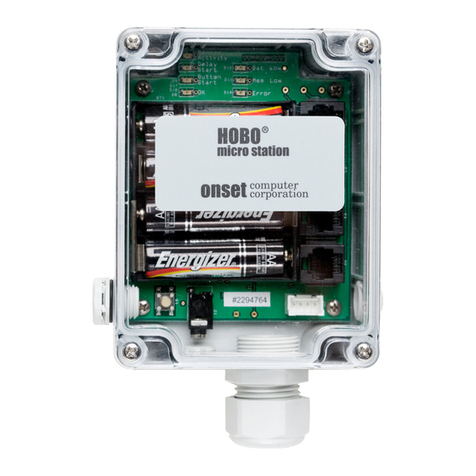
Hobo
Hobo Micro Station User manual
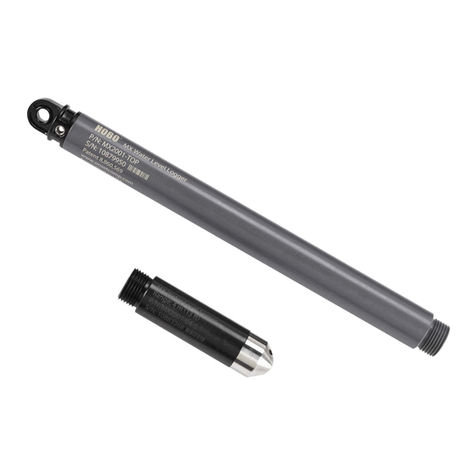
Hobo
Hobo MX series User manual
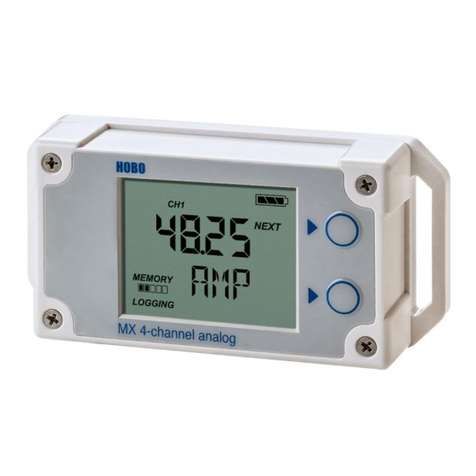
Hobo
Hobo MX1104 User manual
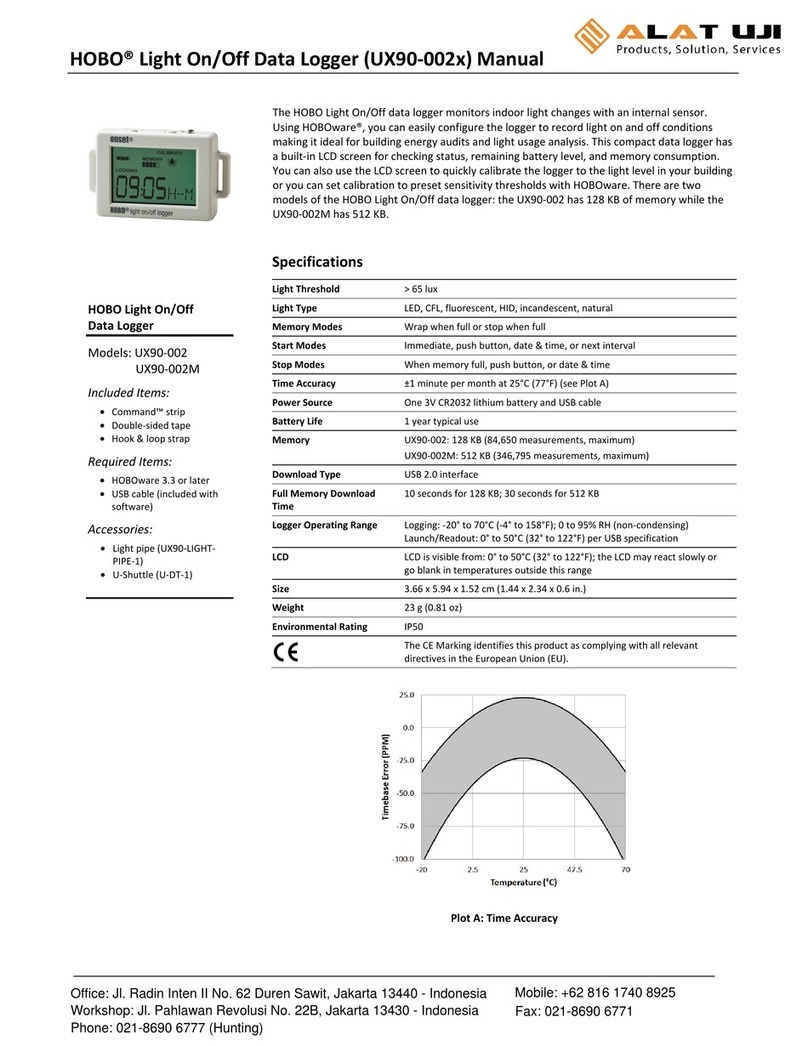
Hobo
Hobo UX90-002 Series User manual
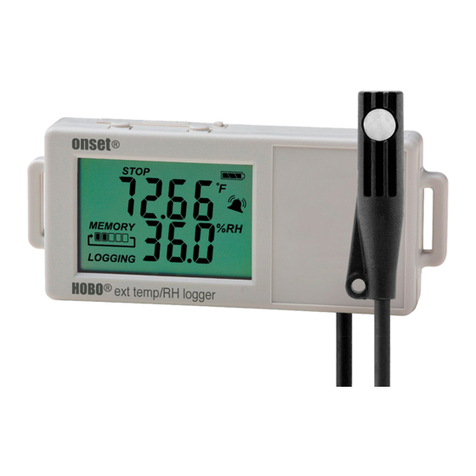
Hobo
Hobo UX100-023A User manual
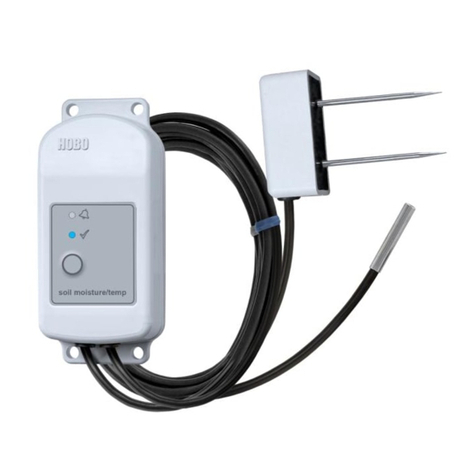
Hobo
Hobo MX2306 User manual

Hobo
Hobo H8 Pro User manual
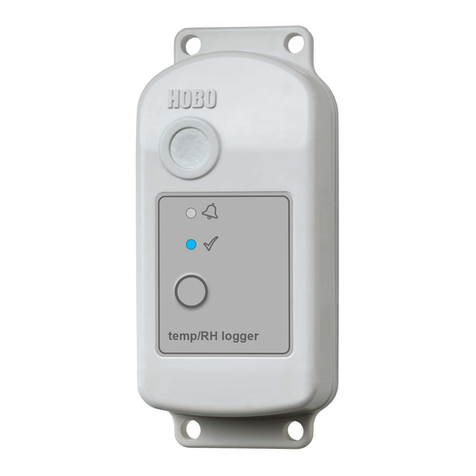
Hobo
Hobo MX2300 Series User manual
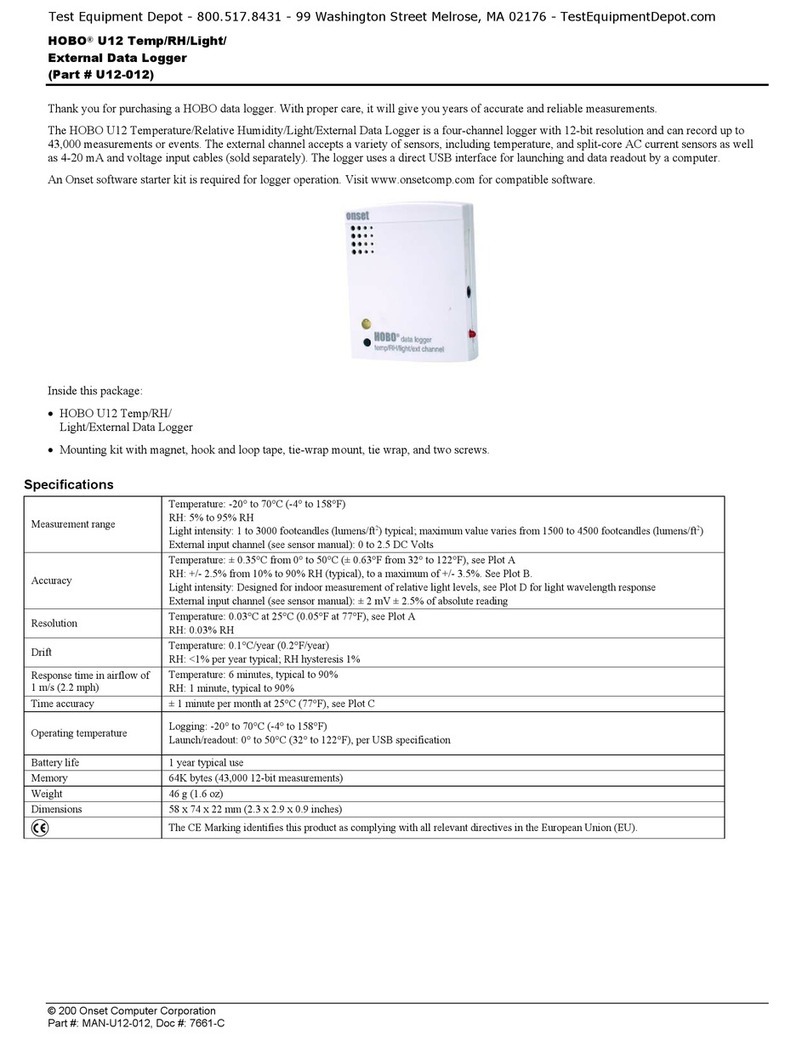
Hobo
Hobo U12-012 User manual

Hobo
Hobo MX2501 User manual
